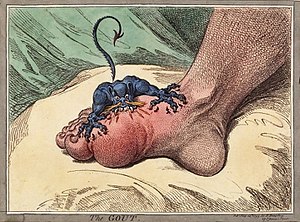Purine: Difference between revisions
No edit summary |
No edit summary |
||
| Line 1: | Line 1: | ||
<!-- seo --> | <!-- seo --> | ||
{{#seo: | {{#seo: | ||
|title= | |title=Purine, what is this gout causer? Cooking Wiki | ||
|titlemode=replace | |titlemode=replace | ||
|keywords= | |keywords=#purine #liver #mackerel #scallops #asparagus #oatmeal #gravy #herring #wheat #beans #sardines | ||
| | |hashtagrev=12032020 | ||
| | |description=A purine is a heterocyclic aromatic organic compound. Thats the précis, but you want to find the cause | ||
}} | }} | ||
<!-- /seo --> | <!-- /seo --> | ||
[[Image:The_gout_james_gillray.jpg|300px|thumb|right|The depiction of gout; 1799]] | [[Image:The_gout_james_gillray.jpg|300px|thumb|right|The depiction of gout; 1799]] | ||
===What is a purine?=== | ===What is a purine?=== | ||
A purine is a heterocyclic aromatic organic compound. That's the précis. [http://en.wikipedia.org/wiki/Purine The full explanation] is unlikely to bring any further clarification. However, if you are viewing this from a culinary angle, [http://en.wikipedia.org/wiki/Gout Gout], is probably the reason you are here. | A purine is a heterocyclic aromatic organic compound. That's the précis. [http://en.wikipedia.org/wiki/Purine The full explanation] is unlikely to bring any further clarification. However, if you are viewing this from a culinary angle, [http://en.wikipedia.org/wiki/Gout Gout], is probably the reason you are here. | ||
| Line 32: | Line 31: | ||
[[Category:Ingredients]] | [[Category:Ingredients]] | ||
[[Category:Vitamins, minerals and supplements]] | [[Category:Vitamins, minerals and supplements]] | ||
{{CategoryLineIngredients}} | |||
<!-- footer hashtags --><code 'hashtagrev:12032020'>[[Special:Search/purine|#purine]] [[Special:Search/liver|#liver]] [[Special:Search/mackerel|#mackerel]] [[Special:Search/scallops|#scallops]] [[Special:Search/asparagus|#asparagus]] [[Special:Search/oatmeal|#oatmeal]] [[Special:Search/gravy|#gravy]] [[Special:Search/herring|#herring]] [[Special:Search/wheat|#wheat]] [[Special:Search/beans|#beans]] [[Special:Search/sardines|#sardines]] | |||
</code><!-- /footer hashtags --> | |||
Latest revision as of 18:00, 13 January 2015

What is a purine?
A purine is a heterocyclic aromatic organic compound. That's the précis. The full explanation is unlikely to bring any further clarification. However, if you are viewing this from a culinary angle, Gout, is probably the reason you are here.
Purines are known triggers of gout (or podagra if it only affects the big toe). Causing elevated uric acid levels, the uric acid crystalises and builds up between joints of the big toe, heels, knees, wrists, and fingers. The onset normally occurs because of the lower body temperature at that time.
Foods with a high concentration of purines
Purines are found in high concentration in meat and meat products, especially internal organs such as liver and kidney. In general, plant-based diets are low in purines. Examples of high-purine sources include: sweetbreads, anchovies, sardines, liver, beef kidneys, brains, meat extracts (e.g., Oxo, Bovril), herring, mackerel, scallops, game meats, beer (from the yeast) and gravy.
A moderate amount of purine is also contained in beef, pork, poultry, other fish and seafood, asparagus, cauliflower, spinach, mushrooms, peas, lentils, beans, oatmeal, wheat bran, wheat germ, and hawthorn.
Dietary causes account for about 12% of gout, and include a strong association with the consumption of alcohol.
Gout was historically known as "the disease of kings" or "rich man's disease."
Reference
- http://en.wikipedia.org/wiki/Purine
- http://en.wikipedia.org/wiki/Gout
- http://en.wikipedia.org/wiki/Uric_acid
Find recipes that contain 'Purine'
#purine #liver #mackerel #scallops #asparagus #oatmeal #gravy #herring #wheat #beans #sardines